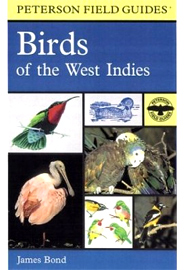 The field guide guiding us on our January 2006 trip to the Bahamas was A Field Guide to the Birds of the West Indies by James Bond. This volume, written by one of the most well respected names in Caribbean aviafauna, edited by Roger Tory Peterson, and illustrated by Don R. Eckelberry, Earl L. Poole, and Arthur B. Singer, was once the definitive guide to the 400+ bird species of the West Indies. Alas, it can no longer lay claim to that title.
The field guide guiding us on our January 2006 trip to the Bahamas was A Field Guide to the Birds of the West Indies by James Bond. This volume, written by one of the most well respected names in Caribbean aviafauna, edited by Roger Tory Peterson, and illustrated by Don R. Eckelberry, Earl L. Poole, and Arthur B. Singer, was once the definitive guide to the 400+ bird species of the West Indies. Alas, it can no longer lay claim to that title.
I enjoyed this volume; trust me, I spent a month devouring every entry. My primary problem with is that it’s just too old. Though published by Houghton-Mifflin in 1999, it hasn’t been updated in decades. Consequently, some of the birds described no longer exist, having been split, lumped, or renamed in the intervening period. One example is the listing for the Greater Antillean Pewee. This lovely flycatcher, called the crescent-eyed pewee by the locals (though you wouldn’t know that from this book) was split by the AOU into three separate pewees, Cuban, Jamaican, and Hispaniolan respectively in 1983. One encounters this oversight again and again in the field.
The other flaw in this book is that it is too sparsely illustrated. What few color plates exist are scattered throughout the guide, rather than inserted close to the written descriptions of the subjects. Though many of the illustrations are excellent, I found a few of them, such as La Sagra’s Flycatcher (called Stolid herein even though the Bahama race split some time ago), Loggerhead Kingbird, and the aforementioned pewee, poor representations of the birds in life. The black and white drawings sprinkled throughout are sometimes not as detailed and descriptive as one would need. A further failing is that, for the most part, only Caribbean specialties are depicted. One would be well served to supplement this book with a field guide to eastern North America for help with the abundant migrants. Our Sibley Field Guide to Birds of Eastern North America certainly put us in good stead.
A Field Guide to the Birds of the West Indies may be most interesting not for its value in the field, but for its author. This particular Bond, James Bond was not the infamous international man of mystery known as Agent 007, but he was the British super spy’s namesake. Dan Koeppel addresses the genuine connection between birding and fictional espionage as an aside in his own spectacular memoir, To See Every Bird on Earth:
“…Novelist Ian Fleming was an avid lister and lived in Jamaica on an estate called ‘Goldeneye’ (named after a species of duck). When he was trying to name the hero of his soon-to-be-famous series of thrillers, his eye wandered to his own bookshelf, where he saw (A Field Guide to the Birds of the West Indies). Finding the author’s name to be suitably “dull and anonymous” he appropriated it for secret agent 007.” (p. 142)
All in all, I found A Field Guide to the Birds of the West Indies helpful, but not as good as it could or should have been. I have it on good authority that Birds of the West Indies by Herbert Raffaele is the authoritative text for visits to the Bahamas and many other islands in the Greater Antilles. Still, the Bond book occupies a distinguished place in Caribbean birding history.













I am a power line design engineer researching design criteria for a project in the Bahamas. In the US, we follow avian protection guidelines aimed to reduce the risk of bird strikes and/or electrocution. Most of the guidelines for geometric limits on insulator and conductor spacing are based upon maximum wing span and maximum height of a standing bird. Could you tell me what the maximum wing spans and heights might be for the largest bird in the Bahamas? If not, can you point me to an accessible source for this information? Your assistance would be greatly appreciated.
You should definitely consult an ornithologist on this question. However, you’ll certainly want to accommodate birds like Great Blue Herons, which can exceed 6 feet in wingspan.